An oval diamond has an elongated round shape that evokes an understated elegance, but with a difference. When it is faceted in the brilliant style, its fire can rival that of a round brilliant. So get ready to pick the perfect oval diamond.
In this blog, we cover:
Anatomy of an Oval Diamond
History of the Oval Diamond
Famous Oval Diamonds
What to Look for in an Oval Diamond
Oval Diamond Engagement Ring Settings
Anatomy of an Oval Diamond
An oval diamond is a fancy shape. You can think of it as a round brilliant diamond stretched on its sides, or a rounded version of a cushion shape or cushion brilliant. To pick a beautiful oval diamond, you need to know its parts.
Head or end: The “tips” of the oval.
Shoulder: The curved area reaching from the head/end to the belly.
Belly: The central area where the sides curve out the most.
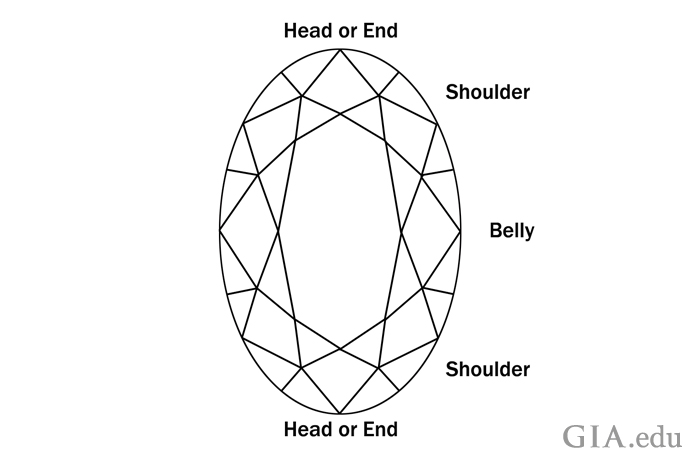
Knowing the anatomy of an oval diamond will help you pick one you love. Illustration: GIA
You’ll typically find oval diamonds cut in the brilliant faceting style, which means the diamond has 57 or 58 facets, like a standard round brilliant, giving it similar visual qualities. An oval diamond can have a variety of facet arrangements, but the most common is eight bezel facets on the crown combined with eight main facets on the pavilion.
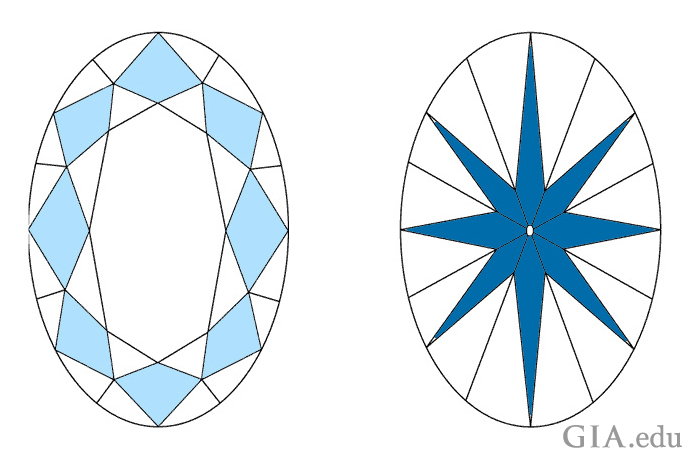
A common facet arrangement for oval diamonds: eight bezel facets on the crown, pictured in light blue (left); eight main pavilion facets, pictured in dark blue (right). Illustration: GIA
There are compelling reasons why many people love oval diamonds: Because the oval diamond has a larger surface area than a round diamond of equal carat weight, it can appear larger to the eye. The oval shape can make the finger seem longer. And because the shape doesn’t have sharp angles or corners, an oval diamond is less prone to chipping compared to other fancy shapes.
History of the Oval Diamond
The brilliant faceting style was first introduced circa 1700. Brilliant-cut cushion shaped diamonds predominated because cutters tended to follow the outline of the rough crystal. But diamonds were available in a variety of shapes, including oval. At this time, diamonds were not described by their shapes – they were simply called “brilliants.” It isn’t until the late 1800s that we first see mention of oval diamonds in literature.
Modern appeal for the oval diamond began in 1957. The oval diamond enjoyed a resurgence between 1998 and 2001, driven in part by marketing campaigns, and now it’s making a comeback. According to Town & Country magazine, the oval diamond ranked 6th in popularity with American consumers in 2016 (round diamonds were still no. 1).
Famous Oval Diamonds
The 105.60 carat (ct) Koh-i-Noor is probably the most famous oval diamond. It was so valuable that it was said that “whoever owned the Koh-i-Noor ruled the world.” Following centuries in the possession of rulers from Persia and India, the diamond was presented to Britain’s Queen Victoria on July 3, 1850. It is now set in the Queen Mother’s crown, which was fashioned for Queen Elizabeth, wife of George VI (and mother of Elizabeth II), for their 1937 coronation. You can see it in the Tower of London with the other Crown Jewels.
The 31.06 ct Wittelsbach-Graff (long known as the Wittelsbach Blue) is another famous oval diamond with a royal provenance. The rough probably came from India’s famed Golconda District. In about 1666, it was given as part of a dowry for the marriage of Infanta Margarita Teresa of Spain into the House of Hapsburg. In 1722, it was used again as part of a dowry, this time for a marriage into the House of Wittelsbach. In 1931, the Wittelsbach Blue vanished from sight and was hidden for 30 years, until it was rediscovered in 1961. After it was sold at auction for $24.3 million in December 2008 to London Jeweler Lawrence Graff, the original 35.56 ct cushion modified brilliant diamond was recut to a 31.06 ct oval to make it a Fancy Deep blue, Internally Flawless gem, and was renamed the Wittelsbach-Graff.

Pictured here is the 31.06 ct Wittelsbach-Graff diamond, recut from the historic Wittelsbach Blue. The recut diamond was graded Fancy Deep blue according to GIA’s colored diamond color grading system. Photo: Robert Weldon/GIA
Another oval diamond made international news in April 2017, when Hong Kong jeweler Chow Tai Fook bought a 59.60 ct Internally Flawless, Fancy Vivid pink diamond for $71.2 million. Known to many as the Pink Star or Steinmetz Pink, it became the most expensive diamond ever sold at auction. The retailer renamed it the CTF Pink Star. The diamond was mined in Botswana in 1999. It took cutters two years to turn the 132.50 ct rough into its final shape.

The Pink Star, now called the CTF Pink Star, smashed auction records when it sold for $71.2 million in April 2017. The 59.60 ct Internally Flawless, Fancy Vivid pink diamond is a stunning example of an oval shaped diamond. Courtesy: Sotheby’s
What to Look for in an Oval Diamond
Turn to the 4Cs of diamond quality when shopping for an oval diamond. GIA uses the same criteria for determining carat weight, color and clarity for oval diamonds as it does for round brilliants. This can help you narrow your search.
Length-to-Width Ratio
Keep proportion in mind when looking at oval diamonds. Consumers and trade professionals tend to prefer a longer oval shape, according to a comprehensive survey of shape preferences GIA conducted in 2009. The survey showed that the most popular length-to-width ratio for ovals was 1.7:1. However, it is not practical to cut such long oval diamonds from the original rough, so you’ll rarely find one. More typical are ovals with ratios ranging from 1.3:1 to 1.4:1.

This 1.06 ct oval diamond has a 1.71:1 length-to-width ratio. It is rare to find oval diamonds this long. Photo: Kate Waterman/GIA
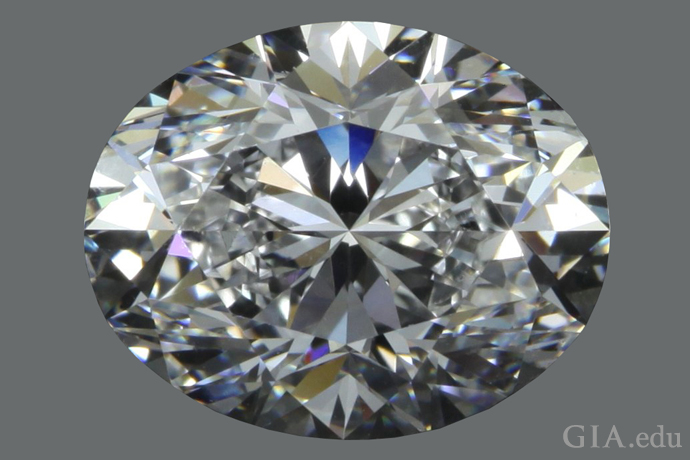
This 3.01 ct oval diamond has a 1.26:1 length-to-width ratio, which is a little shorter than most oval diamonds. Photo: Kate Waterman/GIA
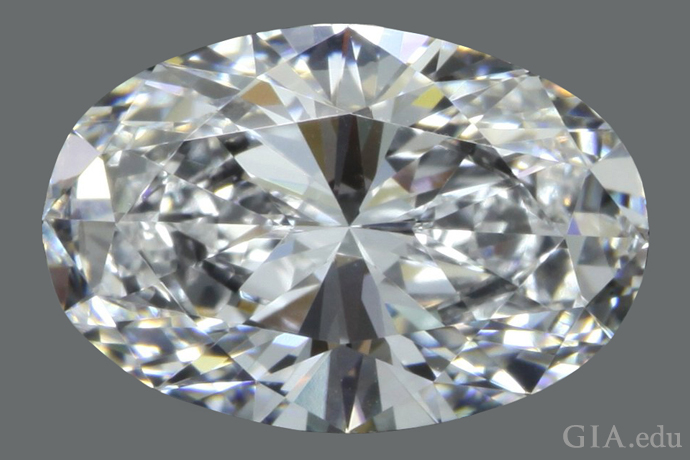
This 2.28 ct oval diamond has a 1.48:1 length-to-width ratio. Even this length is a little hard to find. Photo: Kate Waterman/GIA
Symmetry
Symmetry is important in creating the beauty of an oval diamond. To determine if an oval diamond is symmetrical, draw an imaginary line down the center. The shape and faceting of the two halves should mirror each other. Then draw an imaginary line across the middle of the oval. Again, the shape and faceting of the two halves should be identical.
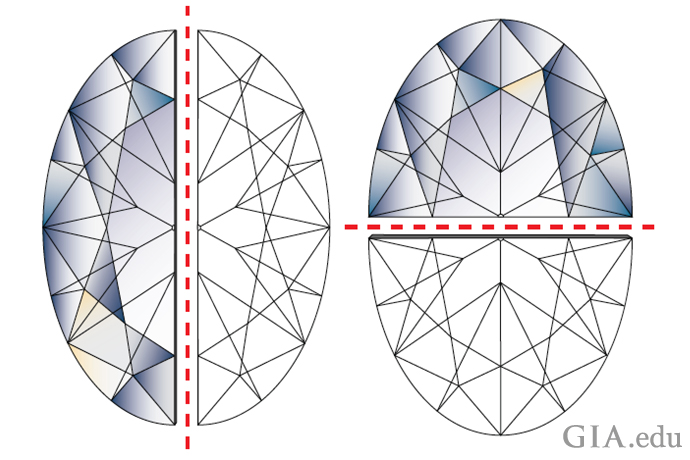
Symmetry is based on how closely the shape and facets on either side of these imaginary center lines mirror each other. Illustration: Peter Johnston/GIA
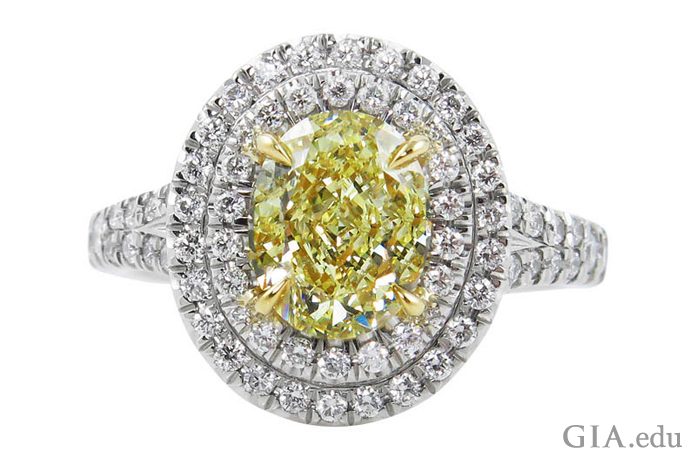
The allure of an oval diamond is easy to see in this 1.58 ct Fancy yellow oval. The two halos surrounding it contain D-to-F color melee diamonds totaling 1.20 carats. Courtesy: TrueFacet.com
Shape Appeal
Look for an oval diamond with a graceful outline and harmoniously proportioned parts. To find one that’s attractive to you, it pays to compare several different oval diamonds. Here are some common shape variations:
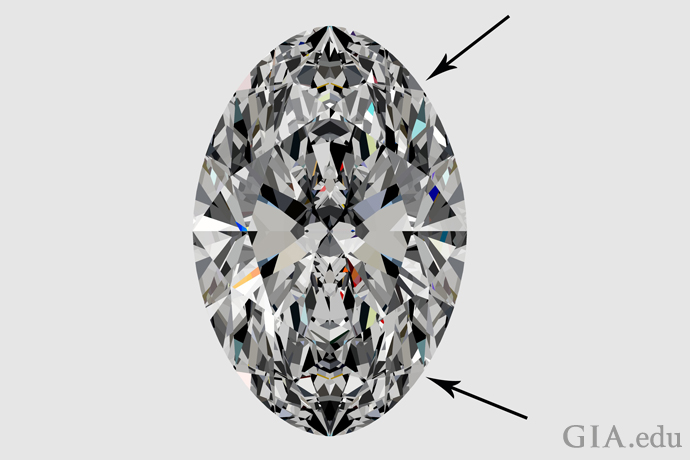
This oval cut has flat shoulders, which many in GIA’s survey considered less graceful. Image: Al Gilbertson/GIA
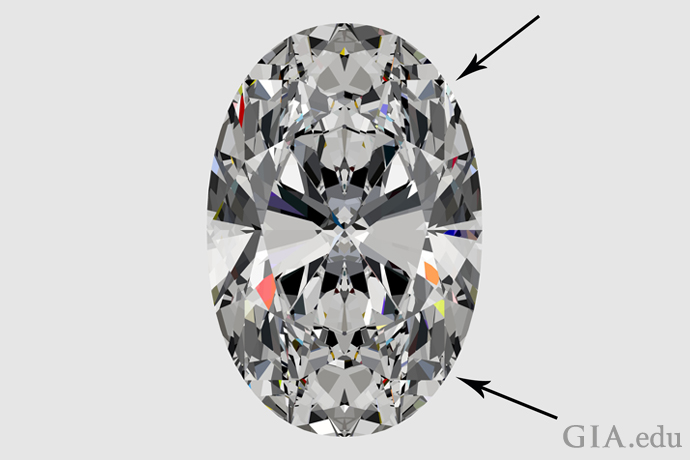
This oval cut has bulging shoulders – an aspect that many of those surveyed also considered less graceful. Image: Al Gilbertson/GIA

This oval cut has no shoulder bulge. Its overall symmetry and well-proportioned shape contribute to its visual appeal. Image: Al Gilbertson/GIA
Girdle Thickness
The girdle is the intersection of the crown and pavilion. It defines the perimeter of the diamond and functions as its setting edge. Girdle thickness is judged the same way in fancy shapes as in rounds. Be sure to look at the diamond’s proportion diagram in its GIA Diamond Grading Report. The diagram will show the stone’s average girdle thickness percentage and indicate if the girdle is too thick or too thin. An overly thick girdle can contribute to a heavier diamond than its face-up appearance warrants, and a thin girdle can increase the risk of damage such as chipping.
Bow-tie Effect
Expect to see a bow tie. A “bow tie” in diamond parlance is a dark bow-shaped pattern across the table of the diamond.
What causes a bow tie? A diamond’s facets act like a series of mirrors that gather light from around you and return it to your eye. As you look at the stone, the dark contrast you see is a reflection of your head and shoulders blocking light from entering the diamond. The closer your face is to the diamond, the more pronounced the bow tie will be.
If the diamond is cut well, the bow tie will be minimal, but once you are in front of the diamond, there will always be some measure of a bow tie.

The grayed-out area across the table in this illustration is where you’ll likely see the bow-tie effect. Illustration: Peter Johnston/GIA
Oval Diamond Engagement Ring Settings
You’ll have lots of choices for engagement ring settings for oval diamonds. And each setting can create a dramatically different look. Here are some options.
Halo Setting
A halo of smaller diamonds around the oval center stone is a lovely addition. It accentuates the shape and makes the diamond appear larger. Choosing a different color of metal or side stones can create an arresting look.
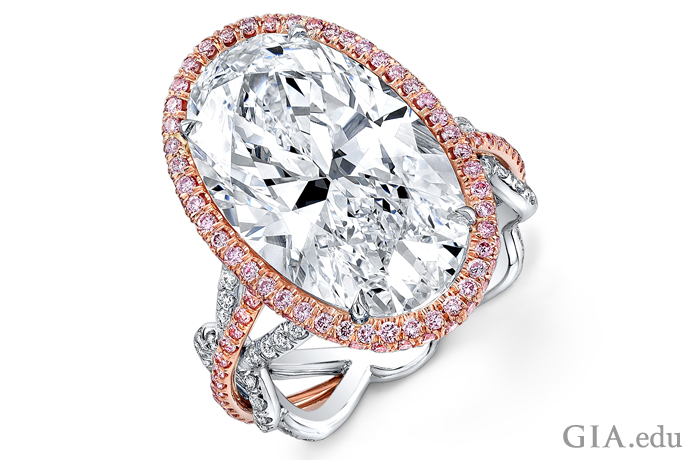
A mesmerizing sight, this oval diamond engagement ring features a 10.92 ct center stone, accented with a halo of fancy pink melee diamonds. Courtesy: Rahaminov Diamonds
Prong Setting
Prong settings are good choices for an oval diamond. Not only do they protect the diamond from loss, but they can also add height, raising the diamond from the band and drawing the eye to the gem.

An oval diamond makes a dramatic statement in a prong setting. A halo of smaller diamonds adds even more panache. Courtesy: Rahaminov Diamonds
Bezel Setting
A bezel setting, which completely encloses the perimeter of the diamond in metal, is a great choice if you lead an active life. It’s an effective way to protect the diamond and also enhances the beauty of the oval shape.

A 0.84 ct oval shape diamond sits in a platinum bezel setting. Courtesy: 1stdibs.com
Side Stones
An oval diamond goes well with virtually any kind of side stone. Half-moon diamonds echo its shape, so they can be an attractive choice. Baguettes and tapered baguettes offer an opportunity to create contrast, as do colored gems. If you want your diamond side stones to match the center oval, choose side stones that are within one or two color grades of the larger diamond so they don’t compete with its beauty.

Contrasting colors and shapes bring life to this engagement ring. It features a 0.90 ct oval center stone, flanked by two round sapphires and round diamonds. Courtesy: EraGem.com
Wide Band
Because of its shape, an oval diamond works well with a wider band.

Three oval diamonds look at home in a wide band. It especially suits the 1.57 ct center stone. Courtesy: EraGem.com
An oval diamond is beautiful…classic…and a little different. It’s a wonderful option for an engagement ring.
If you’re looking to create a diamond engagement ring that’s out of the ordinary, there are many more fancy shapes to choose from. A marquise diamond just might be for you.
Custom Field: Array
